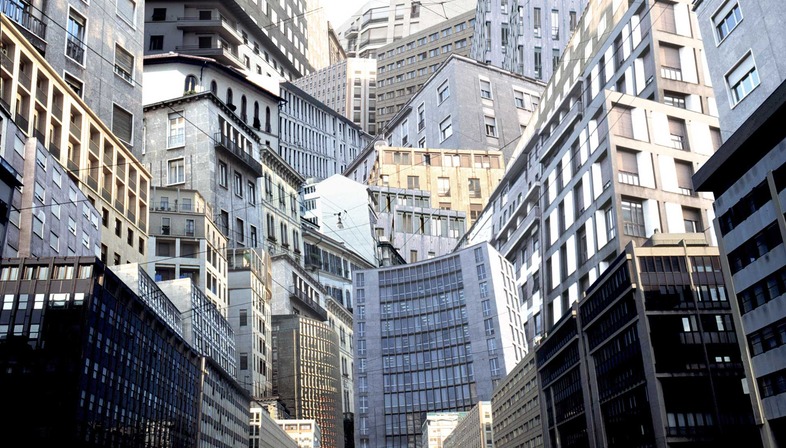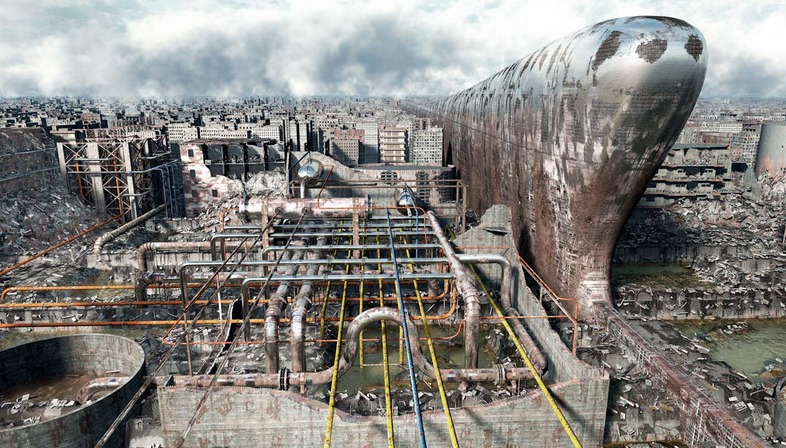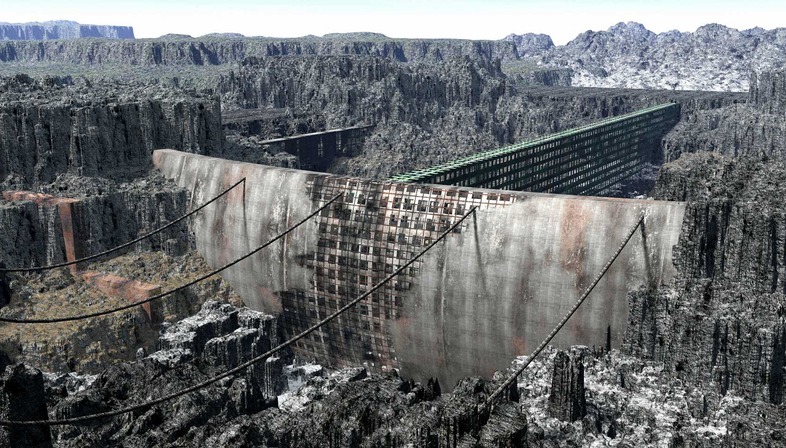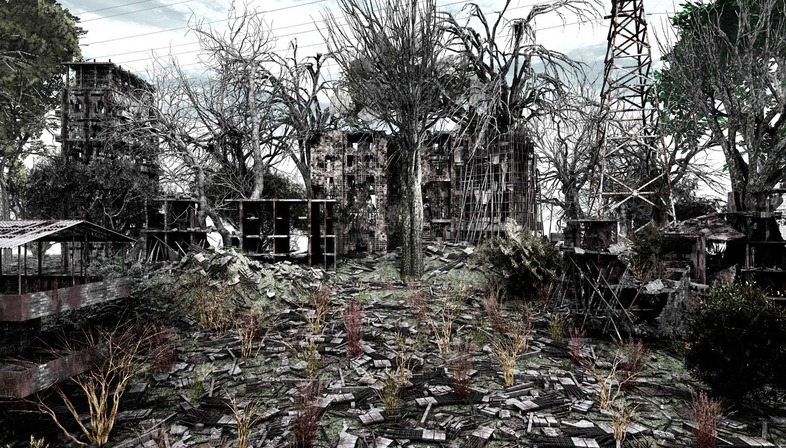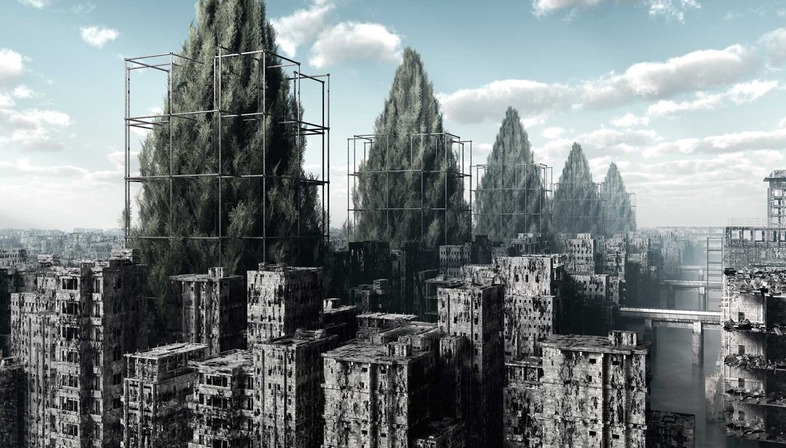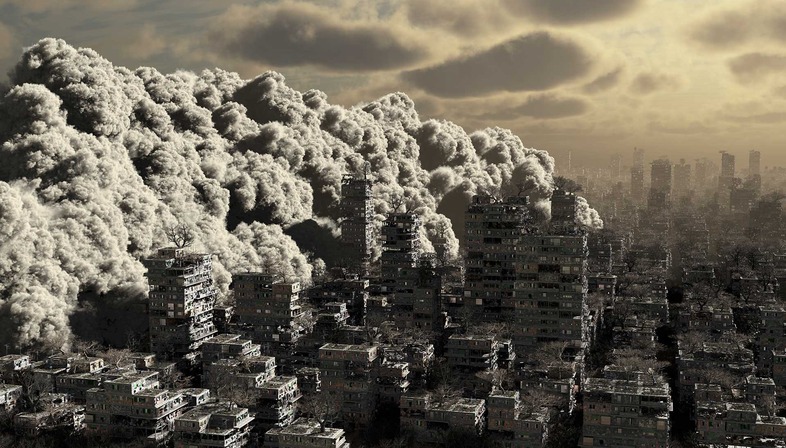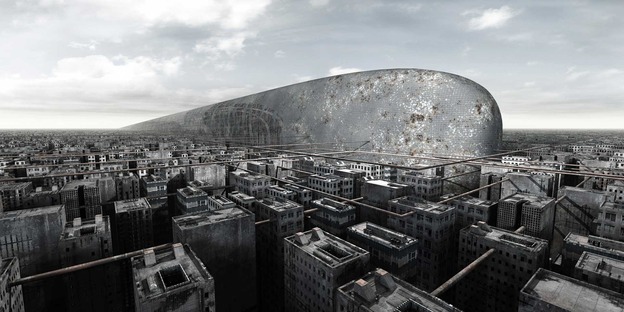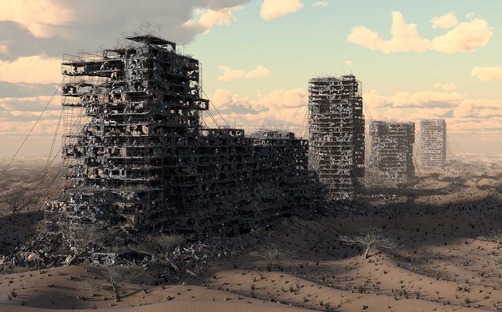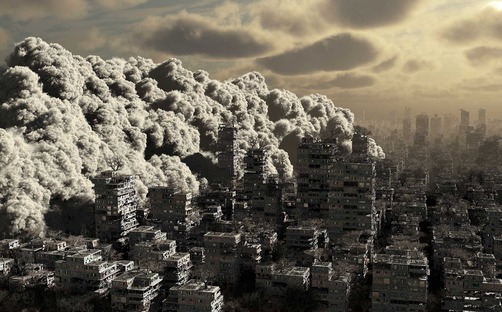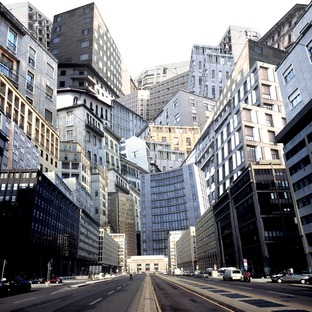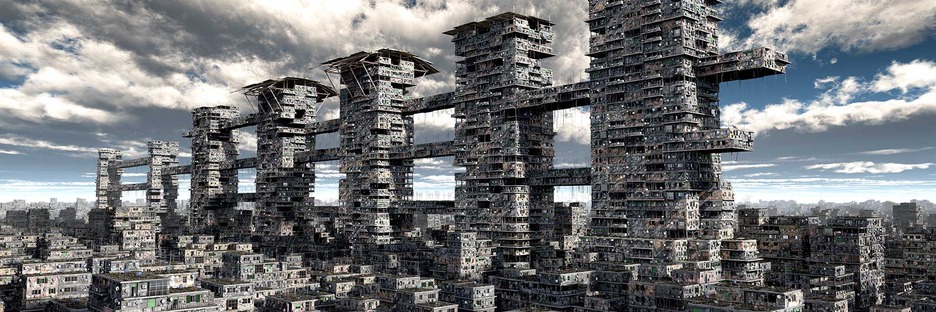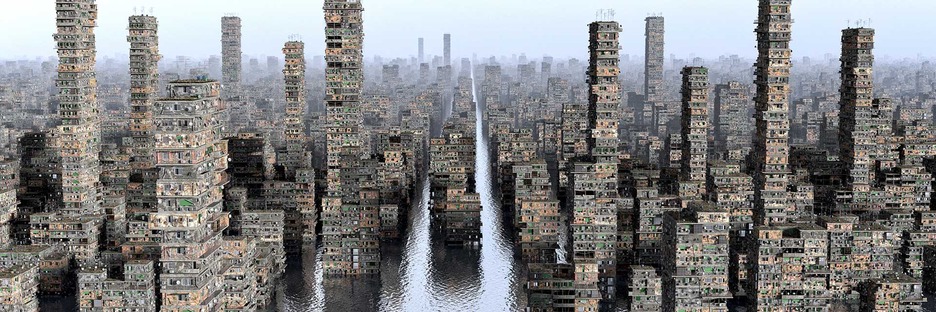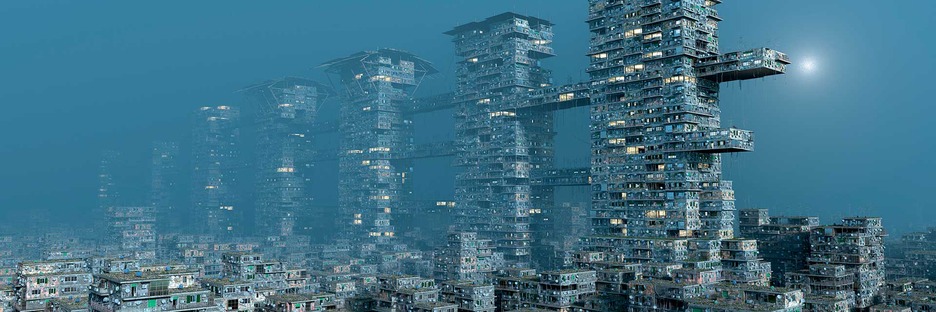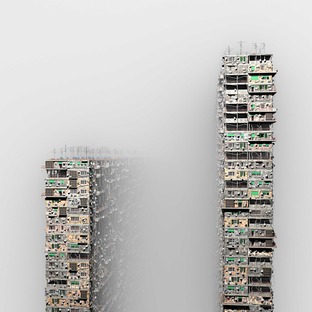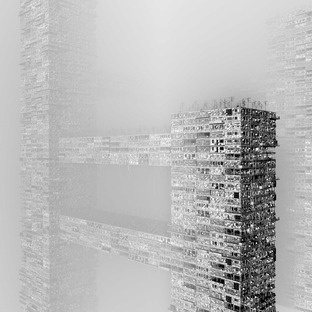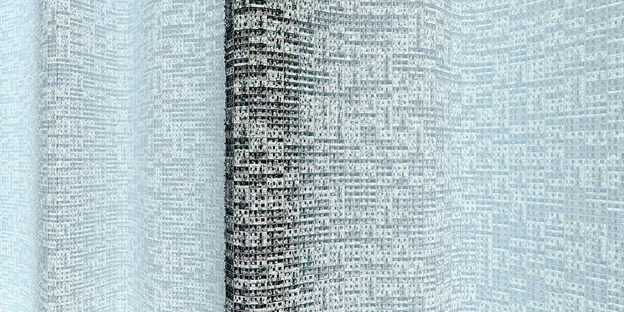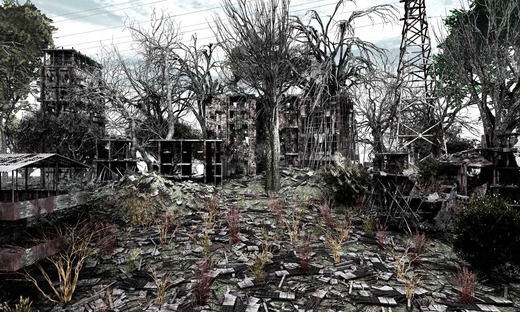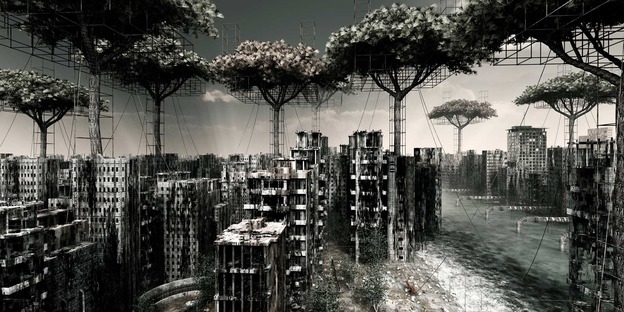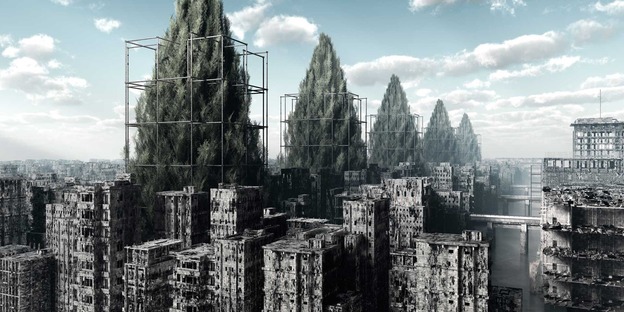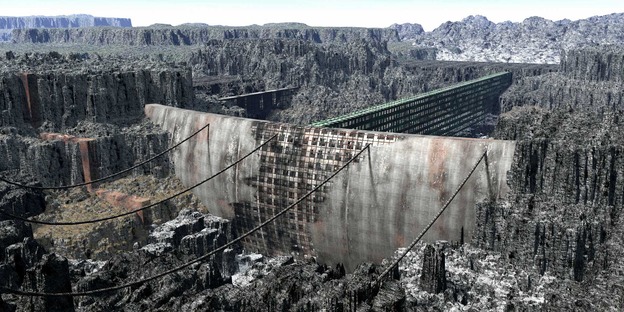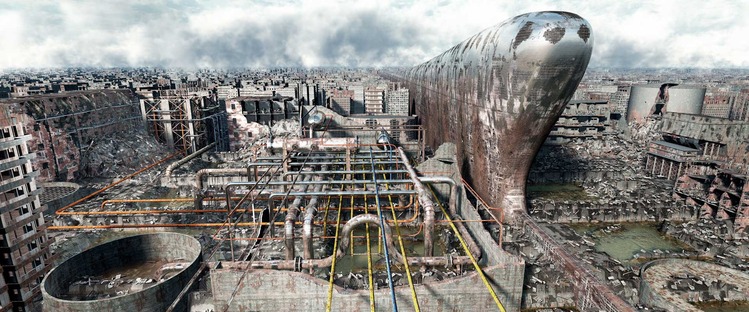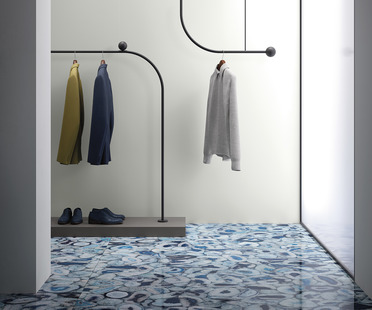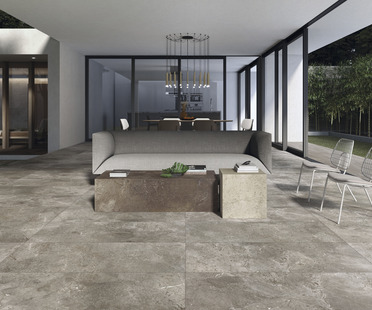03-08-2021
GIACOMO COSTA
Giacomo Costa,
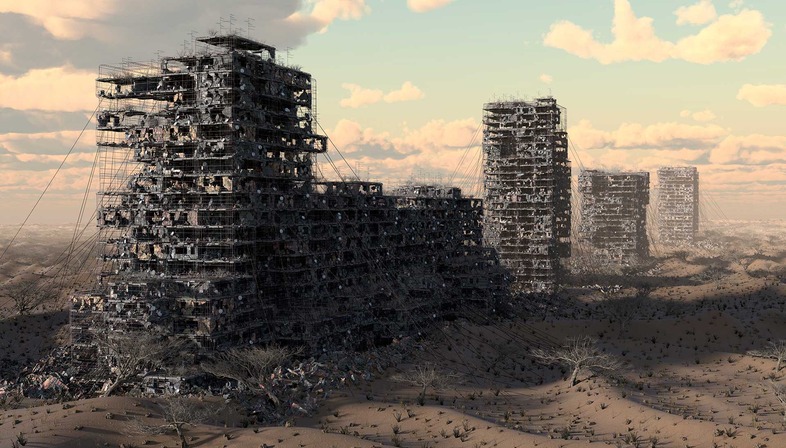
Paused...
The city with the pollution it produces and the expected quantitative growth is at the center of this reflection to which offer their significant contribution eminent artists who have the capability, with the strong graphic impact of their creations, to raise awareness of a wider and above all younger audience. Making use of representations, which have made the urban context the primary subject of their narratives, they have woven stories able to integrate with the extraordinary suggestiveness, a very important narrative from an environmental and social point of view. Settings, sometimes inspired by literature belonging to the world of science fiction and 'cyberpunk', often considered a product of pure fantasy, which have contradicted our reticence when we found ourselves in the fabulous scenarios they foreshadowed.
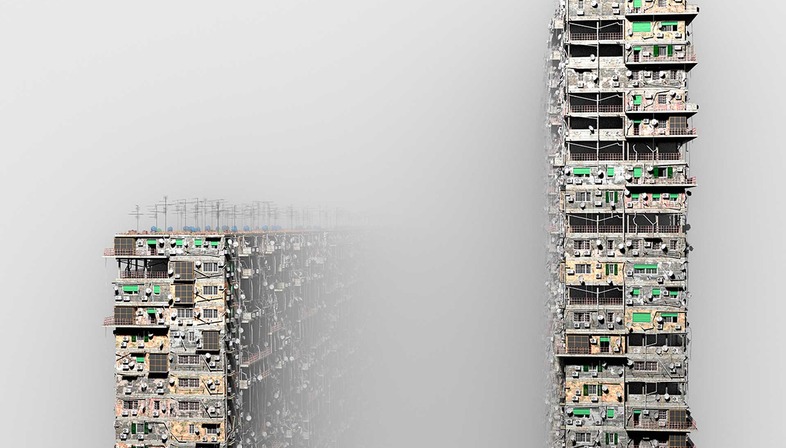
Atmosfere. 'Atmosfera n.18' . Giacomo Costa.
It is with a particular, I would say catalyzing force, that Giacomo Costa's powerful and provocative oversized images, refined digital elaborations of photography that result in real painting, emotionally involve in their urban visitations with visions of landscapes that the author does not intend to impose as catastrophic forecasts but as considerations arising from a current development model that reveals seriously compromised the interaction between man and the environment. They unfold as evidence of a latent need, become increasingly urgent, a discontent to be shared with the rest of humanity, making it clear that the direction taken, towards which we are moving forward, is definitely the wrong one. Costa's artistic career seems inseparable from a path that, undertaken by free will, was then obliged to abandon. Although, endowed with a good dose of self-irony, he minimizes what happened, the new adventure, that he was forced to face, caused him many frustrations, deeply affecting decisions that represented the beginning of his authentic success. Leaving an ambience that satisfied his ideals, based on moral codes of respect and solidarity, privileging introspection, he started to feel a strong sense of estrangement from what the new metropolitan daily life reserved for him.
From the early years of his adolescence he had shown intolerance towards impositions and rigid schemes and, after an attempted career, reckless but also liberating and full of exhilaration, as a motorcyclist, he indulged in two other activities which he was very passionate about. He took refuge in the Alps, where he spent a period of time, dedicating himself to climbing mountains and to photography, an ancient love that at that time amateur and commercial allowed him to maintain himself. Unfortunately, there will be an accident and the obligation of military service will occur which, even if fulfilled with civil volunteering, forced him to return to Florence, his hometown. More and more restless and intolerant, he is unable to accept the idea of well-being and progress prevailing in centers where the population density contrasts with the painful isolation, to which people appear condemned, in part by the unacceptable rhythms of everyday life and in part by the paradoxical greed, which made forget those bonds of spontaneous collaboration, so normal when in the company of a group of friends he was used to organize teams with the enthusiastic mutual support of all in the attempt to reach particularly difficult and coveted peaks.
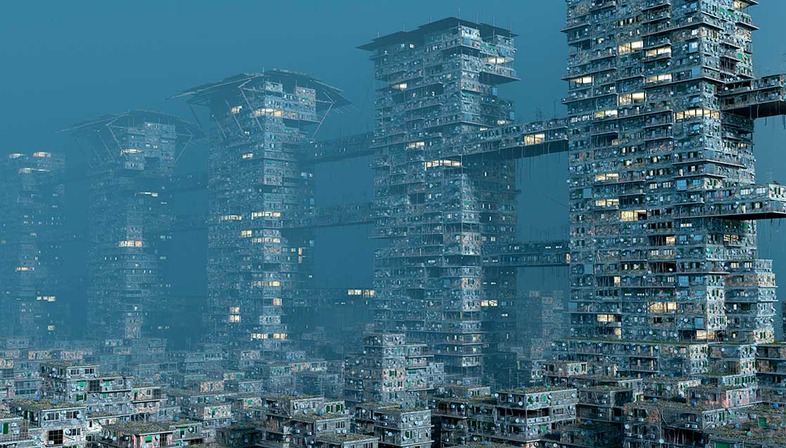
Atmosfere. 'Atmosfera n.8' . Giacomo Costa.
He is unable to share this unanimously acclaimed and pervasive progress and it is through a slow gestation that he will mature how to attest the terrible consequences that an inner voice suggests to him. It will be a day when, arriving in Milan, he will experience with greater intensity than usual the sensation of suffocation, overwhelmed and oppressed by the compactness of a multitude of houses leaning against each other, that he will make a decision that will represent the starting point of the his art. After having spent years almost as a hermit, in contact with an uncontaminated nature, he cannot bear to feel the lack of air and from this almost claustrophobic state germinates ‘Agglomerato n.1', the first of a long series of dense compositions, apparent collages made from clusters of tall imaginary buildings, deliberately proposed with distorted perspectives to convey the effect of that anxiety and that disorienting malaise by which he was assaulted.
The reinterpretation of the urban space through the manipulation of photos offers him an extremely effective visual support to express and transmit his moods and photomontages, as those of ‘Agglomerati’, obtained with very common means, such as retouching in Photoshop, are gradually replaced by more advanced photographic clones. The language becomes more refined, through the use of sophisticated digital tools, softwares created for architecture and cinema. 3D technologies that allow him, abandoning the use of photographic textures but not the intrinsic concept of the discipline, to work on different levels, in virtual spaces with special effects, helping him to become the demiurge of intentionally conceived compositions, dizzying increasingly futuristic perspectives, which, exceptionally reproducing the sense of three-dimensionality, confer an impressive authenticity to the surreal worlds that, living in his mental imaginaries, materialize with the illusory hyper-realistic force of a photographic shot. Each assumption and prediction are legitimized by a great abundance of small features and an attention dedicated to detail with obsessive and meticulous care. The complex virtual construction process is not limited to pure formal research but responds to very specific purposes: the intent is to capture the public by deceiving and seducing people transmitting the message in a more convincing way.
Fond of science fiction, it is somewhat with the same spirit of certain sets created for these film adaptations that he sublimates his perceptions, fears and obsessions about a future that could reserve so much bitterness if the obtuse self-referential behavior of those, who feel authorized to dominate all, will not repent. The city decontextualized metaphorically attests, as emblematic personification of man, the consequences he has caused, as result of his arrogant supremacy and insatiable greed. The architecture, an integral part of the scenography, beautiful and aberrant, soaring towards the conquest of the sky, constantly devoid of human presence, is chosen as a symbol of a real urban anti-ethics. Now it is emphasized in its monumental imprint and colossal conquest achievements with the disturbing presences of dark, impersonal modular elements obsessively repeated, now it lies like a heap of ruins grabbed with rapacity by enormous roots, prey of a nature that seems to have taken its revenge on the concrete and those poor, miserable remains in decay. Its narrative is the fulcrum in this tale of progressive degeneration. The man appears completely absent, are these chilling and crumbling scenarios that represent him in his behavior and remind him in his wicked acts.
Climbing and experiencing the mountain in its powerful manifestations has taught Costa a lesson that should be shared by the rest of humanity, as a warning of their vulnerability and fragility. Feeling omnipotent leads to irreparable mistakes, such as the will to subjugate everything. The sense of suprematism, nourished in man above all by technological advances has on several occasions unveiled weak and obscure sides, proving that before exulting is requested a certain period of time to evaluate the success or failure of the achievements. It is, after all, not the first time that we are experiencing a dramatic consequence caused by this celebrated technology. The Chernobyl disaster and the devastating environmental impact caused by the atmospheric pollution have left an indelible trace in the memories of the artist who often reproposes the ghostly squalor of boundless spaces in total abandonment, slowly devoured by the corrosive action of oxidation and pervaded by skeletons of iron structures, soul of those decaying remains from which rusty bars and tie rods protrude as if to visually retrace the Ukraine area affected by the violent nuclear episode in the 1986.
It is not only the disrespectful treatment, which poisons the environment, making us, in turn, unknowingly victims and the predatory action that has almost irreversibly compromised our resources but it is the same lifestyle imposed by crowded metropolises, deprived of any interaction with greenery and nature, which should push us to reconsider a progress that has perhaps altered in a too disharmonious way the vital relationship that should exist between man and his natural context. The concept of 'well-being' is certainly subjective but the advantages and dangers are quite evident and must be pondered with a certain objectivity. And if we have rights, we also have responsibilities, trying not to transform what is legitimate into illegitimate abuses that can have a dangerous impact on those who will have to pay, even if they are innocent victims. Nature responds to rules that cannot be easily subjected to the impositions that would like to control or even alter it and the unbalanced relationship that we witness especially in inhuman megalopolises leads to a real conflict with fluctuating phases of winners and losers. ‘Scena n.21', one of the various sequences belonging to the homonymous collection, conceived for the 10th Venice Architecture Biennale in 2006, attests to the fearful, irrepressible rebellion that the natural counterpart is about to unleash through gigantic dams which, in the intimidating act to explode, promise to submerge and annihilate with no chance of survival.
In 2009 'Private Gardens' set up a long corridor for the Venice Biennale of Art, inaugurating a research which, focusing on nature, sees it reign, supreme, unstoppable in its advanced urban predatory conquest. In a progression of great poetic lyricism but also of frightening, poignant decay, intimate and private spaces, such as courtyards and gardens, are portrayed pervaded by a chaotic, impenetrable, dense uncontrolled vegetation, left free to grow undisturbed due to the negligence of those who can no longer do anything. Paintings of magical enchantment in their newfound virginity. The plant universe continues its triumphant revenge in the urban views of the 'Plants' series, where some surviving trees have exceeded the towering heights of the built-up settlement with abnormal dimensions, rising to totemic symbols of the new ruling divinity.
Remaining in Venice, still in the framework of the Architecture Biennale, this current edition sees Costa again join the event and it is in the Italian Pavilion that his transgressive pictorial works and his particular sensitivity attest to catastrophic events affecting our cities, our social relations and those with the plant world, caused by triumphalistic behavioral patterns that do not admit the humility of recognizing limits and failures. Even in the past he was able to highlight a problem that has subsequently polarized the attention of scientists and researchers, as in 2008, Norman Foster, his collector and admirer, will highlight in the preface he dedicated to him on the occasion of the publication of 'The Chronicles of Time ', a monographic review of the first twelve years of his artistic production. The famous architect declared that he was particularly impressed by the deep inspiration, even superior to the impeccable, not to say perfect, unanimously recognized technical mastery, and by some intuitions confirmed in that same year by an interesting coincidence: the theme concerning urban density, main and recurring leitmotiv in all the artist’s works, found due credit in having been registered, for the first time in the history of human civilization, a majority of population in cities, which was predicted by statistics that would reach 70% by 2050. And he added, almost as an invitation to reflection: “Giacomo Costa’s visions, with their infinite perspectives and limitless horizons, are like ruins from a lost civilization, which could be our civilization. Through his powerful vision they remind us above all of the fragility of our built world and the civic premises that have so far underpinned it.”
Elementi, 'Elemento n.2'. Giacomo Costa. 17th Venice Architecture Biennale in 2021.
It is not casual when coincidences repeatedly occur and that deafening silence dominating the apocalyptic visions of certain monumental architectures of gloomy lonely structures of a soulless contemporary metropolis, victims of the devastating fury of the four natural elements, of the recent 'Elements' series, part of the itinerary conceived and wanted by Alessandro Melis, evokes the silence and desolating absence of life caused during these months by other fatal calamities sadly prefigured, floods, hurricanes, fires and desertification. It is disturbing to confront ourselves with these extra large paintings that dominate us with their size and that, showing buildings enveloped in a thick fog, provoke moments of disquieting suspension and waiting in front of a prelude that we are not able to understand how it will evolve and however does not seem to allow optimistic expectations. But the author of these potential daunting, catastrophic self-destructions avoids taking himself too seriously and does not like to be identified, due to the gravity of the problems he embraces with his art, as prophet of the end of the world. He downplays and, even if we don't believe him, he says he hopes that man can mend his behaviour, deciding for a change.
Virginia Cucchi
Credits:
Giacomo Costa : http://www.giacomocosta.com/full/










